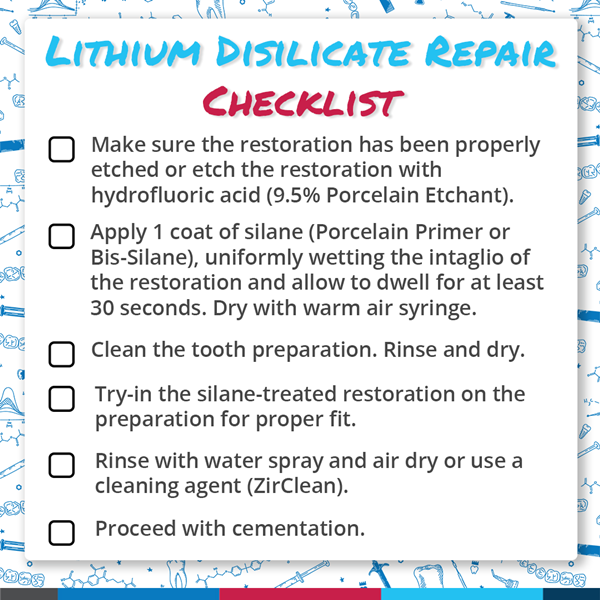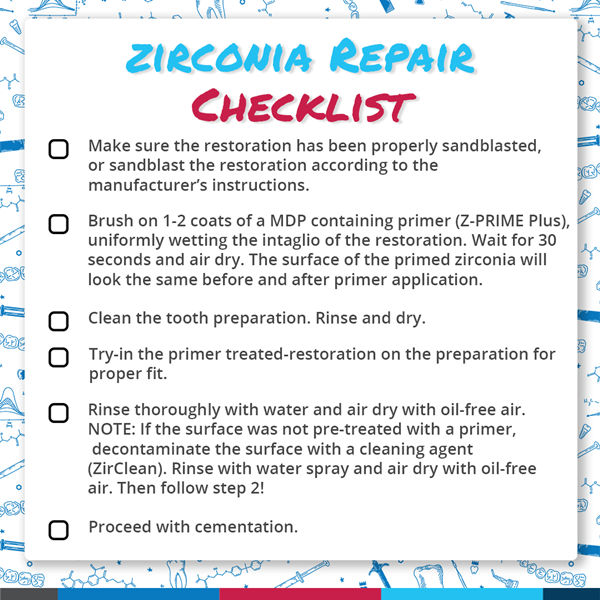Choosing between lithium disilicate (e.max) and zirconia for your indirect restoration can be quite challenging. There are many factors to consider like, strength, esthetics, shade matching, thinness, and position of the proposed restoration (anterior/posterior). But the guidelines for bonding to both remain the same, which includes:
-
Creating mechanical retention.
-
Achieving chemical interaction by surface priming.
It is the dental materials and the methods that will differ for each substrate!
How to create mechanical retention:
Lithium disilicate (e.max) is a glass ceramic substrate.We create mechanical retention by etching the intaglio surface of the restoration with hydrofluoric acid (Porcelain Etchant). On the other hand, zirconia is a non-etchable glass ceramic, thus hydrofluoric acid will not work. The only way to create mechanical retention to the intaglio of the zirconia restoration is to sandblast it prior to cementation or have it pre-sandblasted by the lab.
How to achieve chemical interaction:
The chemical interaction for bonding lithium disilicate restorations is achieved by priming the intaglio surface with a silane primer, such as BISCO’s Porcelain Primer or Bis-Silane™. Zirconia does not contain silica and silane primers have proven to be ineffective with this material.
Learn more about the 5 Fundamentals to Delivering Ceramic Restorations
So how can we achieve chemical interaction to zirconia surfaces?
Research has shown that only when using an MDP containing primer (such as Z-Prime™ Plus) it is achievable1. MDP is a functional monomer that has an affinity to bond to metal and zirconia. This additional reaction generates a covalent bond and, ultimately bond strength.
Is that it? Then why is bonding to zirconia considered a myth?
Bonding to zirconia can be compromised by saliva during try-in. Saliva phosphates and zirconia form ionic bonds depleting the number of available bonding sites on the zirconia surface.2 Simply rinsing the zirconia restoration with water, ethanol or acetone will not work. In order to neutralize the phosphate contamination, the zirconia surface MUST be cleaned with an alkaline solution (such as ZirClean®).3,4
Learn the ABCs of Bonding to Zirconia
Protocol steps:
-
Lithium Disilicate:
-
Make sure the restoration has been properly etched or etch the restoration with hydrofluoric acid (9.5% Porcelain Etchant).
-
Apply 1 coat of silane (Porcelain Primer or Bis-Silane), uniformly wetting the intaglio of the restoration and allow to dwell for at least 30 seconds. Dry with warm air syringe.
-
Clean the tooth preparation. Rinse and dry.
-
Try-in the silane-treated restoration on the preparation for proper fit.
-
Rinse with water spray and air dry or use a cleaning agent (ZirClean).
-
Proceed with cementation.

-
Zirconia:
-
Make sure the restoration has been properly sandblasted, or sandblast the restoration according to the manufacturer’s instructions.
-
Brush on 1-2 coats of a MDP containing primer (Z-PRIME Plus), uniformly wetting the intaglio of the restoration. Wait for 30 seconds and air dry. The surface of the primed zirconia will look the same before and after primer application.
-
Clean the tooth preparation. Rinse and dry.
-
Try-in the primer treated-restoration on the preparation for proper fit.
-
Rinse thoroughly with water and air dry with oil-free air. NOTE: If the surface was not pre-treated with a primer, decontaminate the surface with a cleaning agent (ZirClean). Rinse with water spray and air dry with oil-free air. Then follow step 2!
-
Proceed with cementation.

At BISCO we are here to help! Please phone us at 1-800-247-3368 to help answer your most challenging questions regarding bonding and cementation! Or click here to submit a question to our experts.